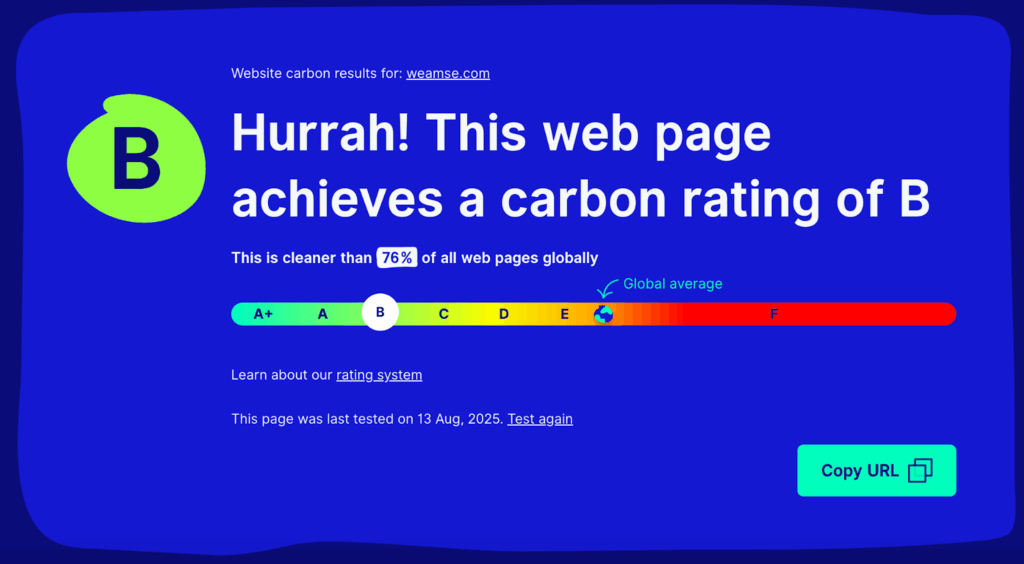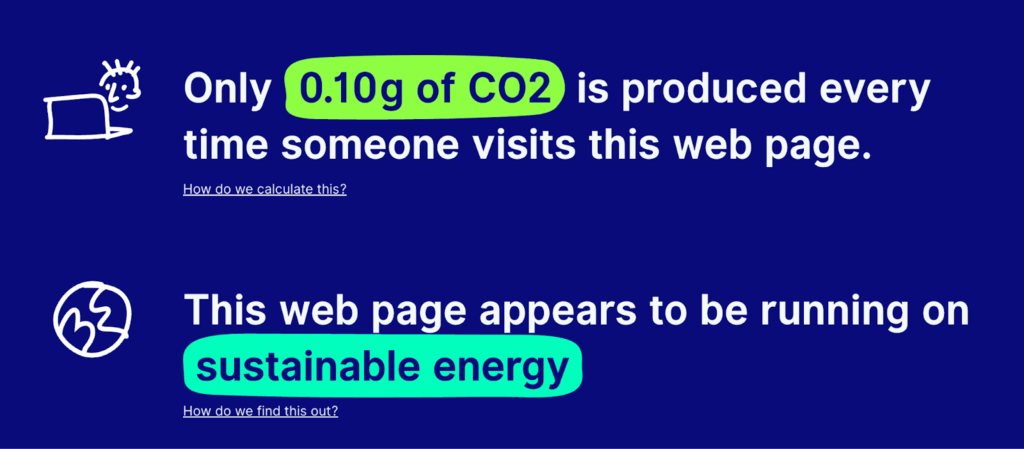Did you know that sustainable website design could be addressing a problem as significant as the aviation industry? The internet accounts for 2-4% of global carbon emissions—matching the environmental impact of all air travel worldwide. Although a single website visit might seem inconsequential, when multiplied by billions of daily users, these digital footprints create a massive environmental burden.
In fact, every online action consumes energy—from data centers to networks to our devices. A single Google search produces between 0.2 to 0.7 grams of CO₂, while an average website generates approximately 1.76 grams of CO₂ per page view. When we consider that poorly optimized websites with heavy media files and inefficient coding use significantly more resources than necessary, it becomes clear why eco-friendly website design is no longer optional. Despite this growing digital carbon footprint, sustainable web design offers practical solutions that can transform your online presence into an environmental asset rather than a liability.


The Environmental Cost of the Web
The internet’s invisible energy footprint is growing at an alarming rate. Currently consuming 1021 TWh of electricity annually—more than the entire United Kingdom—our digital infrastructure creates a substantial environmental burden. This digital ecosystem contributes to approximately 3.7% of global carbon emissions, surpassing the aviation industry.
Data centers and transmission networks alone account for 1-1.5% of global electricity use, with each aspect of our online experience requiring energy. Consider that a single web page generates about 0.36 grams of CO2 per view. For a website with 10,000 monthly pageviews, that adds up to 43 kg of carbon dioxide annually.
Moreover, this digital footprint is rapidly expanding. Energy consumption from digital technologies is increasing by 9% yearly, with domestic data center usage projected to double or triple by 2028. AI is accelerating this trend dramatically, with AI-related electricity demand expected to quadruple by 2030.
The environmental impact varies significantly based on how electricity is generated. For instance, digital content consumption requires 26% of an individual’s carbon budget under Norway’s renewable-heavy grid, but jumps to 61% under India’s fossil fuel-dependent system.
Consequently, without intervention, our growing reliance on data-intensive services threatens to undermine climate goals. This makes sustainable website design not just beneficial but increasingly essential for future-focused businesses.
Core Principles of Sustainable Web Design
Sustainable website design stands on foundational principles that simultaneously benefit both users and our planet. At its core, this approach puts people and planet first, delivering digital products that respect clean, efficient, open, honest, regenerative, and resilient principles.
Efficiency drives sustainable web design, creating streamlined websites that load quickly and consume less energy. This involves adopting minimalist design approaches where every element serves a purpose, reducing overall page weight and energy required to load them. Additionally, clean coding practices are essential, as efficient, well-organized code reduces server processing load, leading to lower energy consumption.
Furthermore, accessibility forms a crucial pillar of sustainable design. By making websites usable by individuals of all abilities, designers contribute to a more inclusive digital ecosystem. This includes ensuring sufficient color contrast, keyboard navigation, and screen reader compatibility.
Mobile-first design inherently promotes sustainability through prioritizing essential content. This approach forces developers to consider what content and features are most important for users with small screens or limited bandwidth. By following this principle, websites display less content, requiring less energy to load while improving the user experience.
Most importantly, these principles yield tangible benefits beyond environmental impact. Sustainable websites load faster, perform better, and provide superior user experiences. A well-optimized site not only reduces its carbon footprint but also increases usability, enhancing both business outcomes and ecological sustainability.
Practical Strategies for an Eco-Friendly Website
Turning sustainable website design principles into action requires specific technical choices that reduce your digital carbon footprint. Ready-to-implement strategies can make your website both environmentally responsible and user-friendly.
First, choose green web hosting—the foundation of eco-friendly websites. Look for providers powered by renewable energy sources with high Power Usage Effectiveness (PUE) ratings. The Green Web Foundation’s directory lists over 500 verified green hosting providers.
Next, focus on media optimization. Images account for nearly half of all data transferred on the web. Compress images using tools like TinyPNG, implement lazy loading so resources only load when needed, and utilize modern formats like WebP and AVIF that provide 50% better compression than JPEG.
For videos—the heaviest digital elements—limit usage, avoid autoplay, use lower resolutions, and consider third-party hosting through YouTube or Vimeo.
Setting up caching stores frequently used data locally, reducing server requests and energy consumption by up to 30-40%. Similarly, implementing a Content Delivery Network (CDN) serves assets from locations closer to users, minimizing data travel.
Finally, conduct regular content audits to remove unused themes, plugins, and media files. Tools like Website Carbon and Ecograder can help measure your site’s environmental impact, guiding your optimization efforts.
Conclusion
Sustainable website design represents a powerful opportunity for businesses moving toward 2026 and beyond. We’ve seen how the internet’s carbon footprint rivals that of the entire aviation industry, making digital sustainability not just beneficial but necessary. The rapidly growing energy demands of our digital ecosystem, especially with the rise of AI technologies, further underscores this urgency.
Actually, the principles of sustainable web design align perfectly with business objectives. Efficient, clean-coded websites load faster, perform better, and deliver superior user experiences. This creates a rare win-win situation where environmental responsibility directly enhances business outcomes rather than competing with them.
Furthermore, many practical strategies exist for immediate implementation. Green hosting, media optimization, and proper caching can dramatically reduce your website’s environmental impact without sacrificing functionality or esthetics. These techniques work together to create lighter, faster sites that consume less energy throughout the digital supply chain.
Though transitioning to sustainable design practices requires some initial investment, the long-term benefits undoubtedly outweigh these costs. Your business gains improved performance metrics while simultaneously reducing its environmental impact. Essentially, sustainable web design transforms what could be an environmental liability into a competitive advantage.
Therefore, as we look toward a more environmentally conscious future, sustainable website design stands as a secret weapon for forward-thinking businesses. By embracing these principles today, you position your digital presence at the intersection of environmental responsibility and business excellence – precisely where tomorrow’s most successful brands will thrive.
Key Takeaways
Sustainable website design is becoming essential as the internet generates 2-4% of global carbon emissions—matching the entire aviation industry’s environmental impact.
• Choose green hosting providers powered by renewable energy to reduce your website’s foundational carbon footprint • Optimize images and videos using compression tools like TinyPNG and modern formats like WebP for 50% better efficiency • Implement caching and CDNs to reduce server requests and energy consumption by up to 30-40% • Adopt mobile-first, minimalist design principles that prioritize essential content and improve loading speeds • Regular content audits remove unused plugins and files, keeping your site lean and energy-efficient
Sustainable web design creates a powerful win-win scenario: environmentally responsible websites load faster, perform better, and deliver superior user experiences. As digital energy consumption grows 9% yearly and AI demands quadruple by 2030, businesses that embrace sustainable design practices today position themselves as leaders in tomorrow’s environmentally conscious marketplace.
FAQs
Q1. What is sustainable website design?
Sustainable website design is an approach that focuses on creating efficient, eco-friendly websites that minimize energy consumption and carbon emissions while providing an excellent user experience. It involves optimizing code, reducing file sizes, and using green hosting solutions.
Q2. How does website design impact the environment?
Website design impacts the environment through energy consumption. Poorly optimized websites with heavy media files and inefficient coding use more server resources and energy to load, contributing to higher carbon emissions. The internet currently accounts for 2-4% of global carbon emissions.
Q3. What are some key principles of sustainable web design?
Key principles include efficiency in layout and navigation, clean and optimized code, minimalist and mobile-first design, and accessibility. These principles not only reduce energy consumption but also improve website performance and user experience.
Q4. How can I make my website more eco-friendly?
To make your website more eco-friendly, choose green hosting providers, optimize images and videos, implement lazy loading and caching, minimize third-party scripts, and regularly audit your content to remove unnecessary elements. These strategies can significantly reduce your website’s carbon footprint.
Q5. What are the benefits of adopting sustainable website design? Adopting sustainable website design offers multiple benefits. It reduces your digital carbon footprint, improves website loading speeds and performance, enhances user experience, and can lead to better business outcomes. It also positions your brand as environmentally responsible, which is increasingly important to consumers.
